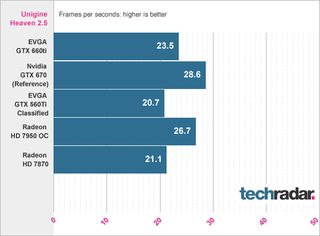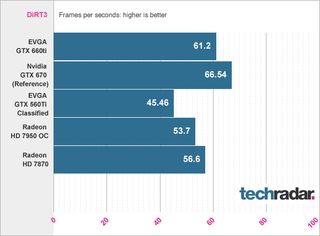Why you can trust TechRadar
As expected the performance of the GTX 660Ti is quite good indeed, coming within striking distance of the more-expensive GTX 670 and soundly beating the Radeon HD 7870. It even beats the $369 Radeon 7950 OC in some tests as well, which is rather awesome.
Just for fun we tested two GTX 660Ti cards in dual-care SLI configuration, though they were not the same card as you see in this review. However, the cards we tested had a mild overclock compared to the EVGA board, but we can expect similar results.
The scaling performance was almost precisely double in every test, which is mighty impressive. In testing the dual 660Ti cards even bested the mighty GTX 680, though they fell short of besting the dual-680 laden GTX 690, but that's to be expected given its staggering price tag and fully loaded arsenal of CUDA cores. Unless you have a really big monitor and need to run all games at 2560x1600 with AA enabled, you should be fine with a single GTX 660Ti.
All the benchmarks were run on the highest settings at an eye-popping 2560x1600 resolution with 4X MSAA enabled. Our test bed consisted of an Intel Core i7-3960X at stock speeds on an Asus P9X79 Deluxe board with 16GB of DDR3/1600 RAM, a 256GB Samsung 830 series SSD drive and a 1050W Thermaltake power supply.
DirectX 11 tessellation performance

DirectX 11 gaming performance



Performance
A lot of what we wrote for our review of the GTX 670 can be rewritten here - this card performs very well, which should not come as a surprise at all given its Kepler heritage. Though it's a slightly neutered version of its bigger brother, there's just a small difference between the two cards in terms of specs, size and performance.
Just like the GTX 670 this card still has seven SMX units for a total of 1,344 CUDA cores, and they both offer the same core clock speed, memory clock frequency and Boost clock frequency as well, making the GTX 660Ti very, very similar to its predecessor. They both also sport 2GB of fast GDDR5 memory.
When examining the numbers we see the GTX 670 clearly coming out on top, but only by between five to 10 frames per second in most tests, which is hardly the difference between a game being playable or not.
In Far Cry 2 the difference is the most stark at almost 20fps, but the 660Ti is already pushing over 80fps, so it's extremely playable even at the insane resolution of 2560x1600. We also see the GTX 660Ti toppling its previous generation doppelganger, the GTX 560Ti by a decent margin, especially in Dirt 3 and Metro 2033, but not by a wide enough margin to really shock us.
We also see the GTX 660Ti taking a clear victory over the AMD HD Radeon 7870 card in every test except for Metro 2033 where the two are neck-and-neck. The GTX 660Ti even gives the more expensive HD 7950 a run for its money in most tests as well, which is surprising and backs up Nvidia's marketing smack talk about how the card is able to run with bigger, badder foes while consuming less energy.
The card also runs relatively cool as well, as we loaded it up for a few hours and not only did the card automatically overclock itself from the stock 980MHz to 1132MHz, it also remained stable at 63C the entire time. And then as soon as we lightened the GPU load the clock speeds reduced, the fan spun down and it carried on being the quiet, unassuming graphics card it was designed to be.
All this great performance puts AMD on the hotseat as it doesn't quite have a direct competitor with the HD 7870 performing below the GTX 660Ti and the more expensive HD 7950 outperforming it just slightly in some tests, and being a tad slower in other tests. Since the HD 7950 is already released, and the flagship HD 7970 won't be coming down in price any time soon, we'll have to wait for a refresh from AMD to compete directly with Nvidia this time around, but perhaps an HD 7960 is right around the corner?

